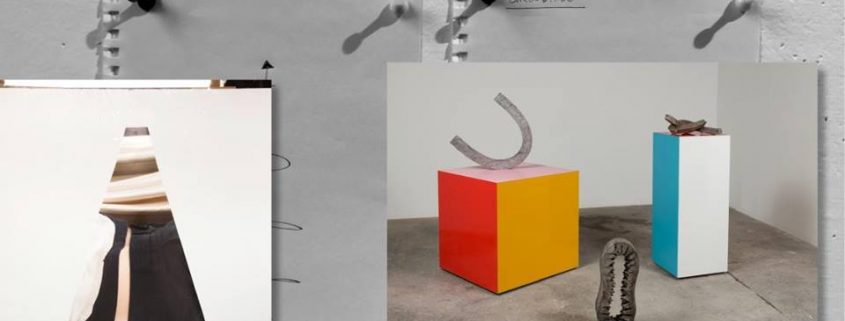New exhibitition at MOCA Grand Avenue underwhelms
MOCA Grand Avenue’s storefront: Public Fiction: The Poet and The Critic, and the missing installation consists of a small room outside the main gallery directly across from the museum store. The exhibit runs until June 19.
This compact space lives entirely behind glass, not unlike a commercial display window. Within, the space contains a large painted cube, an elegant hanging wire sculpture, a ceramic beach ball, a small, dark, possibly ceramic sculpture, a horizontally oriented flat-screen TV with an image of an Eames chair and accompanying text and two organic wave-like objects composed of what appears to be white and beige plastic. The windows themselves are adorned with several poems, all of which relate to each other aesthetically and typographically.
According to MOCA’s description of the installation on their website, the artists who created the space are Nathaniel Mackey, Nevine Mahmoud and Lynne Tillman, but only Tillman’s name is visible by merely looking through the glass. Furthermore, labeling the storefront “a place for work that is motivated by passion rather than commercial agendas or market trends” in the description both obscures the economic concerns perpetually underscoring the art-making process and indicates that perhaps MOCA is not financially supportive of these artists.
While this description could easily be dismissed as a mere idealized art world trope, it becomes somewhat more sinister when considering the deliberately worded misinformation also present in the installation description. This text depicts MOCA as “founded by artists,” but a quick Wikipedia search reveals that MOCA was in fact, like most other large art institutions, the brainchild of the Los Angeles County Mayor Tom Bradley, City Councilman Joel Wachs, philanthropist Marcia Simon Weisman and several major art collectors in 1979. While MOCA’s theoretical commitment to the initiatives of local artists is admirable, their branding is overly idealized and ultimately downright misleading.
This distortion renders the space not only physically inaccessible, but conceptually as well — the entire installation lacks the transparency to be truly public. Though the whole room can be seen from outside and requires no entrance fee, the doors to the interior are locked and the glare on the glass is intense, making the space difficult to engage with. The individual artist names are minimized and the history of the institution is reworked to fit the theme. It is unclear how the objects in the space or the people that made them embody the idea of public art, public fiction or greater accessibility. Overall, this gives the installation and the objects within it a feeling of opacity at odds with the concept of “the public.”
Sadly, this show falls into the trap of attempting to address “the public” as an impersonal concept through irritatingly unapproachable methods commonly associated with “high” art. Furthermore, some of the wording in the show description indicates the persistence of problematic notions of art as outside capitalist interests and descriptive of the human condition but not comprehensible to the average person. That being said, the publication associated with the installation featuring artists, critics, and poets Sophia Al Maria, Corrine Fitzpatrick, Quinn Latimer, Ann Lauterbach, Fred Moten and Michael Palmer is much more engaging. The layout is hip and simple and the entries are limited to 200 words. In effect, this sparse combination of images and text is a much more concise, interesting, and approachable version of a less successful physical manifestation.
In summation, storefront: Public Fiction is a compelling concept with a well-made publication attached, but not an event worth penciling in unless one arrives early for a reservation at the Broad or a show at the Walt Disney Concert Hall.

